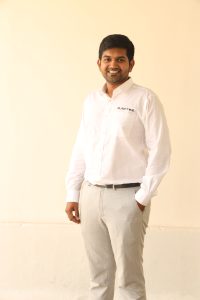Новини світу мікро- та наноелектроніки
Raptee Sets the Stage for Two-Wheeler EVs in India
Raptee is a full-stack two-wheeler EV startup with their flagship product highly tech-enabled and IoT-centred. The team began operations out of Chennai in 2019 with a mission to democratise electric mobility in India. They are crafting a two-wheeler EV that is more of an augmented machine which is intelligent, intuitive and safe with features like throttle mapping, blind-spot detection, and Bluetooth connectivity. So far, Raptee has over 31 technological patents in its name.
 Mr. Dinesh Arjun, CEO & Cofounder, Raptee
Mr. Dinesh Arjun, CEO & Cofounder, Raptee
Rashi Bajpai, Sub-Editor at ELE Times spoke with Mr Dinesh Arjun, CEO and Co-founder at Raptee on various aspects of EV with a prime focus on the Indian market.
This is an excerpt from the conversation.
- Can you throw some light on the go-to features/ major USP of Raptee’s electric motorcycle?
Our bikes come with an onboard charger that plays an essential role in bidirectional charging modes thus making the riding experience hassle-free. Additionally, we stand out as the only electric two-wheeler company in India to leverage the ubiquitous CCS2 charging standard. This compatibility grants you access to the extensive public charging network, allowing you to top up your bike from 0 to 80% in a mere 45 minutes.
- What core technologies and concepts does the team Raptee work on? Please highlight your key expertise and core competencies.
As the sole electric two-wheeler (e2W) utilizing a high-voltage drivetrain, we deliver superior performance surpassing any internal combustion engine (ICE) counterparts. The seamless integration of VCU and cloud computing not only enhances rider experience with smoother acceleration and improved handling but also offers practical benefits like efficient trip planning through real-time battery status updates, showcasing Raptee’s commitment to innovation and practical functionality on the road.
- As India moves towards self-reliance in the area of information and technology, a wave of innovations and ideas has taken over the nation. How well is Raptee prepared to pursue development in the EV sector under the “Make in India” policy?
Raptee substantiates its alignment with the “Make in India” policy through its complete in-house design and development of all components. This comprehensive approach not only ensures technological sovereignty but also fosters a culture of innovation and expertise within the domestic industry. Additionally, Raptee’s establishment of a complete supply chain ecosystem from scratch addresses a critical gap in the market, particularly concerning high-voltage technology. This initiative not only reduces dependency on imports but also enhances the resilience and competitiveness of India’s EV sector.
- What is your view on EV battery swapping booths and can its implementation help India come closer to sustainable electric mobility?
As battery technology evolves, the range of EVs is steadily increasing, reducing the need for frequent charging. This improvement diminishes the perceived advantage of battery swapping, which is often promoted as a quick solution for limited-range EVs. As batteries become more energy-dense and charging times decrease, charging stations become more efficient and comparable in terms of convenience.
- India’s electric two-wheeler (E2W) sector is expected to cross the one million mark in 2024-what are the factors that will influence the market to reach the mark?
India’s E2W market is on an electric revolution, with sales expected to breach the one-million mark in 2024. This surge is driven by a customer-centric approach. Gone are the days of limited choices. Manufacturers are offering diverse options, from high-performance motorcycles to practical everyday rides, catering to every rider’s needs. Range anxiety is fading too, with advancements in battery technology and a rapidly expanding charging network. Additionally, robust customer support with readily available service and informative resources empowers riders, building trust and confidence in E2Ws. This focus on customer satisfaction, coupled with innovation and infrastructure development, is paving the way for a million E2Ws and a sustainable transportation future for India
- How can better implementation of the charging infrastructure accelerate the sales of EVs?
A well-developed charging infrastructure plays a pivotal role in accelerating electric vehicle (EV) sales by addressing critical consumer concerns. Firstly, it alleviates the fear of “range anxiety” among potential buyers by ensuring a widespread network of charging stations along highways and in urban areas, thereby assuring drivers they can recharge conveniently during their journeys. Secondly, the availability of fast-charging stations, such as those utilizing the CCS2 standard, significantly reduces charging times, making EVs more competitive with traditional gasoline vehicles. This not only enables quicker trips but also enhances overall convenience by minimizing wait times at charging stations. Moreover, a robust charging infrastructure sends a powerful message to the public, signaling that EVs are a practical and supported transportation choice. This reassurance can sway hesitant consumers, ultimately driving increased EV adoption.
- Tell us about Raptee’s goals and vision for the next decade.
Raptee’s vision is nothing less than a revolution in personal mobility. We are committed to accelerating the shift towards safe, smart, and sustainable transportation solutions, making them accessible to everyone. Fueled by a deep-tech core, we’re pioneering innovative technologies like HV drivetrains to achieve this ambitious goal.
Our focus isn’t limited to electric vehicles. We see ourselves as architects of the future of mobility, constantly exploring new product landscapes based on customer preferences and inventing disruptive technologies across different segments.
By the next decade, Raptee aspires to be a global leader in personal mobility, with a significant market share. This leadership will be built on the foundation of our unwavering commitment to safety, sustainability, and cutting-edge technological innovation.
The post Raptee Sets the Stage for Two-Wheeler EVs in India appeared first on ELE Times.
CEA-Leti Selected to Coordinate Two EU Projects for Developing ‘First-Class’ 6G Capabilities and Contributing to Standardization
Engaging Multiple EU Partners, the Projects Will Apply Intelligent Sensing and AI-enabled Learning Technologies
As part of the European Union’s drive to support a multifaceted approach to addressing 6G challenges and promises, CEA-Leti has been chosen to coordinate two projects to help build first-class 6G technology capabilities and boost standardization efforts across Europe.
The two projects were among 27 chosen in a competitive proposal process by an EU partnership that divided €130 million between the projects. “These projects present a significant stride towards advancing smart networks and services, offering breakthrough innovations, experimental platforms and large-scale trials, driving world-class research and shaping the world’s digital connected future,” said the group, called the Smart Networks and Services Joint Undertaking (SNS JU).
6G-DISAC (Distributed Intelligent Sensing and Communication) and 6G-GOALS (Goal-Oriented AI-enabled Learning and Semantic Communication Networks) launched their three-year projects in January with multiple EU collaborators.
The two projects mark the first time a single RTO or company has been chosen to coordinate two competitive EU proposals in the same initiative. CEA-Leti has coordinated several EU projects, including the recently completed RISE-6G project. That SNS JU effort developed a disruptive new concept as a service for wireless environments by dynamically controlling wireless communication for brief, energy-efficient and high-capacity communications on a variety of surfaces, such as such as walls, ceilings, mirrors and appliances.
6G-DISAC
This project will develop and innovate on a widely distributed intelligent infrastructure compatible with both real-world integration constraints, new semantic and goal-oriented communication and sensing approaches, and the flexibility requirements of future 6G networks. It will apply theoretical approaches and operational and standards-compatible, distributed joint communication and sensing, by leveraging the expertise of world-leading network vendors, verticals, SMEs, research laboratories and academic institutions spanning the value chain.
Current approaches to integrated communication and sensing use centralized architectures and pass sensed information through a centralized controller.
“This project will bring the integrated sensing and communication (ISAC) vision into reality, going well beyond the usual restrictive standalone or localised scenarios, by adopting a holistic perspective, with large numbers of connected users and/or passive objects to be tracked,” said Emilio Calvanese Strinati, coordinator of the project and CEA-Leti’s smart devices & telecommunications strategy program director.
“With demonstrations that validate the vital 6G-DISAC concepts, the project will revolutionise various applications, from extended reality and robot-human interaction to vehicular-safety functions and improving communication key performance indicators (KPI) with sensing-aided communications,” he explained.
In addition to defining use cases and designing innovative network architecture, the 11 6G-DISAC partners will develop novel physical-layer waveforms, distributed sensing and communications methods, and optimised resource allocation methods and protocols.
Specific targets include:
- tracking connected user equipment (UE) and passive objects,
- performing ISAC with many distributed base stations, efficient distributed signal processing and machine learning for semantic ISAC, and
- incorporating extremely large multiple-input, multiple-output (MIMO) technologies and reconfigurable intelligent surfaces, and intelligent sensing activation.
“While addressing these fundamental and practical challenges, the team will focus on the distributed implementation of ISAC, unlocking real sensing applications and providing a multi-perspective view of networks in space and time for tangible communication gains,” Calvanese Strinati said.
6G-GOALS
This project is designed to reduce data traffic by conveying only the most relevant information and produce data-efficient, robust and resilient protocols that can adapt to network conditions and communication objectives using modern AI/ML techniques.
“As wireless mobile communication requires ever-higher data rates and 5G’s scope expands to include massive and ultra-reliable low-latency links, wireless evolution has been pressed to solve the technical problem of reliable data exchange between two end-points,” said project coordinator Calvanese Strinati.
“The 6G-GOALS project will take the wireless system design to its next stage by considering the significance, relevance and value of the transmitted data and transforming the potential of the emerging AI/ML-based architectures into a semantic and goal-oriented communication paradigm, offering a solid step toward cooperative generative AI technologies,” he said.
Semantic communication is instrumental in inducing reasoning and shared understanding among intelligent agents by exchanging pragmatically selected information in which its meaning to the receiver is designed to efficiently accomplish a goal or a task. With current approaches, data is sensed and transferred from sensors to the destinations without prior semantic extraction functions.
A recent paper written by 6G-GOALS participants noted that advances in AI technologies have expanded device intelligence, fostering federation and cooperation among distributed AI agents. These advancements impose new requirements on future 6G mobile network architectures.
“To meet these demands, it is essential to transcend classical boundaries and integrate communication, computation, control, and intelligence,” the paper, “Goal-Oriented and Semantic Communication in 6G AI-Native Networks: The 6G-GOALS Approach”, reports.
“These projects are fundamental to explore the capabilities of AI/ML solutions on the networks of the future, especially dealing with joint communication and sensing and semantic communications,” said Mauro Boldi Renato, EU project program coordinator at TIM (Telcom Italia). “Working with CEA-Leti represents a solid basis for their success and for bringing European industry towards implementation of 6G around 2030.”
“The exploitation of 6G-DISAC and 6G-GOALS project results will represent a transformative step for manufacturers and 6G industrial players, like NEC Corporation, by fostering the development of distributed intelligent networks and semantic/AI-driven communication strategies,” said Vincenzo Sciancalepore, principal researcher at NEC Laboratories Europe GMBH/ Germany and a member of the 6G-DISAC team. “Such an unprecedented approach will enable more efficient, flexible, and responsive network infrastructures that can support advanced applications, such as extended reality and automated mobility, meeting the increasing demand for high-capacity, low-latency and sustainable communication.”
6G-DISAC Partners
- Coordinator: CEA-Leti/France
- Technical Manager: Chalmers Tekniska Hogskola AB/Sweden
- Innovation Manager: Nokia Networks/ France
- Telecom Italia Spa/Italy
- Orange S.A./France
- Ethniko Kai Kapodistriako Panepistimio Athinon/Greece
- Institut Polytechnique
De Bordeaux/France
- NEC Laboratories Europe GmbH/Germany
- NEC Italia S.P.A/Italy
- Robert Bosch GmbH/Germany
- RadChat AB/Sweden
6G-GOALS Partners
- Coordinator: CEA-Leti/France
- Technical Manager: Consorzio Nazionale Interuniversitario per le Telecomunicazioni/Italy
- Innovation Manager: NEC Laboratories Europe GMBH/ Germany
- NEC Italia S.p.A/Italy
- Telecom Italia S.p.A/Italy
- Eurecom GIE/France
- Aalborg Universitet/Denmark
- Hewlett-Packard/France
- Hewlett-Packard Italiana S.R.L/Italy
- Toshiba Europe Limited UK
- Imperial College of Science Technology and Medicine UK
- Singapore University of Technology and Design
The post CEA-Leti Selected to Coordinate Two EU Projects for Developing ‘First-Class’ 6G Capabilities and Contributing to Standardization appeared first on ELE Times.
maXTouch Touchscreen Controller Family Expands with Additional Security Features for Touchscreen Payment Systems
Microchip’s ATMXT2952TD 2.0 family of touch controllers offer cryptographic authentication and data encryption
As we see an increased number of electric vehicles (EVs) on the road, the necessary charging infrastructure must expand to meet the increased demand. Adding credit card payment options to EV chargers is becoming a standard practice in many countries—and is a mandate in the European Union—and chargers need to meet Payment Card Industry (PCI) security standards. To help EV charger designers protect their payment architectures, Microchip Technology has launched the MXT2952TD 2.0 family of secure touchscreen controllers.
Typical touch-enabled human-machine interface (HMI) and radio frequency identification (RFID) combination-based payment systems are vulnerable to hacking attacks via malicious software updates or man-in-the-middle attacks when a user enters their personal identification number (PIN) on the touchscreen. Physical mesh barriers and sensors are often used around these integrated circuits (ICs) for protection from hacking. Constant reflashing of software and device resets are used to help safeguard software integrity. The MXT2952TD 2.0 family is designed to encrypt touch data and cryptographically authenticate software updates to minimize risk and meet PCI certification compliance standards. When the RFID reader IC and the touchscreen controller are on different printed circuit boards (PCBs), it is especially difficult and expensive to build physical barriers for hack protection. Embedded firmware on the MXT2952TD 2.0 provides a more easily implemented solution for EV charger manufacturers to remain compliant with security regulations and avoid the cost of adding a second, expensive touchscreen payment module to the charger.
The outdoor nature of EV charger HMI demands they withstand harsh weather conditions, function accurately in the presence of moisture and are resistant to vandalism. MXT2952TD 2.0 touch controller-based touchscreens remain effective when designed with IK10 standard 6 mm-thick glass, anti-reflective, anti-glare and anti-fingerprint coatings and IR filter/UV filter layers. Microchip’s proprietary differential touch sensing delivers exceptional noise immunity for superior touch performance even when used with thick gloves.
“The maXTouch 2952TD 2.0 family provides EV charger designers with a cost-effective, secure design architecture for implementing credit card payments with PIN entry on their touchscreens,” said Patrick Johnson, senior corporate vice president overseeing Microchip’s human machine interface division. “Combined with the rugged, outdoor HMI touchscreen technology that Microchip’s maXTouch portfolio is known for, the new addition to the 2952TD family of touchscreen controllers offers our customers secure designs and the exceptional touch performance necessary for outdoor applications.”
In addition to EV chargers, the MXT2952TD 2.0 family is well-suited for most unattended outdoor payment terminals such as parking meters, bus ticketing meters and other types of point-of-sale (POS) systems. The 2952TD 2.0 is specifically optimized for 20” screen sizes and its sister part, the MXT1664TD, is available for 15.6” screen sizes.
The post maXTouch Touchscreen Controller Family Expands with Additional Security Features for Touchscreen Payment Systems appeared first on ELE Times.
I thought the STM32 was a series of 32 Bit wide-market microcontrollers?
 | They are now making 64 bit full Linux capable processors under the “STM32” name. I can understand putting the STM32MP1 series under the STM32 brand, but this should just be a new line of chips at this point. [link] [comments] |
Replacement capacitor
 | I know enough about electronics to get myself in trouble but not much more. My wife's Grandpa had this old 8mm projector and looks like a capacitor was added at some point. It hooks up inside to this transformer (I think). The projector surprisingly works great! But the motor starts to slow down after running for 10-15 min and the capacitor gets real hot. I'm assuming it's going out? As soon as the motor started slowing down I turned it off so I wouldn't break anything. Any ideas on what the specs would be for this capacitor? I looked online and couldn't find any info on a "R50T1 Mallory" capacitor. Any guidance would be greatly appreciated? [link] [comments] |
Upgrades!
 | I’m a senior hardware engineer and one of my favorite pastimes is to take electronic kits that are online or in store and see if I can approve on them a little bit one way or another. I seen this mini “pong” retro arcade kit for pretty cheap and I was like oh, this is screaming for a custom 3-D printed case. Though after I assembled it, I found out that the biggest weakness was it had one of those really tiny piezo speakers. It was also enclosed in the case, so it was really quiet, so I added a KA386 amplifier that I had laying around. This worked pretty well and made it way louder. It’s probably not the most quality audio amplifier these days, but it’s dirt cheap and it works for the 8 bit sounds. [link] [comments] |
Introduction to MOSFET Switching Losses
First Project on perma-proto board
 | First Project that has moved from breadboard to something more permanent. None of the potentiometers are square, and some of the solder joints may make you cringe. But that's how we learn. The code runs about 350 lines of circuitpython. What is it? A fencing training assistant. [link] [comments] |
New knowledge unlocked
 | submitted by /u/spiroy756 [link] [comments] |
Weekly discussion, complaint, and rant thread
Open to anything, including discussions, complaints, and rants.
Sub rules do not apply, so don't bother reporting incivility, off-topic, or spam.
Reddit-wide rules do apply.
To see the newest posts, sort the comments by "new" (instead of "best" or "top").
[link] [comments]
EEVblog 1612 - Siglent SDS1000X HD 12 bit Oscilloscope Teardown
OpenRad: Open-Source Radiation Dosimeter (Chernobyl Anniversary Release)
 | To commemorate the 38th anniversary of Chernobyl, we're launching OpenRad - an open-source project for building your own radiation dosimeter! Built on ESP32 TTGO T-Display and the SBM-20 Geiger tube, OpenRad allows you to monitor environmental radiation. [link] [comments] |
Couldn’t resist making this controller European
 | submitted by /u/wawabreakfast [link] [comments] |
I made a new backplane for my Terramaster F2-221 NAS
Custom PCB: environmental monitoring subsystem
 | submitted by /u/techno-recluse [link] [comments] |
3 Test and Measurement Tycoons Release Tools for Wireless and Beyond
Vibration sensor aids predictive maintenance

Murata’s PKGM-200D-R vibration sensor detects high-frequency vibrations up to 11 kHz to assist predictive maintenance in production equipment. The device measures vibration acceleration along the Z-axis to detect abnormal vibrations, which can indicate early bearing wear and prevent unexpected equipment stoppage.

For rotary bearings, engineers can employ FFT analysis on vibration data to pinpoint irregularities caused by depleted grease or minor surface imperfections. By detecting these anomalies early on, FFT analysis enables proactive intervention, potentially averting impeding issues before they escalate.
Housed in a compact 5.0×5.0×3.5-mm surface-mount package, the PKGM-200D-R integrates a PZT piezoelectric ceramic element, driver circuit, and temperature sensor. Differential analog output reduces line noise. Specifications for the sensor include a detection range of ±10.2 g minimum, a frequency band of 6 kHz to 11 kHz, and sensitivity of 118 mV/g typical.
The PKGM-200D-R vibration sensor requires a supply voltage of 3.0 V to 5.2 V, with current consumption of 3.5 mA. It operates over a temperature range of -20°C to +85°C. The device is now in mass production.
Find more datasheets on products like this one at Datasheets.com, searchable by category, part #, description, manufacturer, and more.
The post Vibration sensor aids predictive maintenance appeared first on EDN.
Generator delivers analog signals up to 40 GHz

A microwave signal generator, the SMB100B from R&S offers four frequency options covering 8 kHz to 12.75 GHz, 20 GHz, 31.8 GHz, and 40 GHz. This midrange analog signal generator provides single sideband (SSB) phase noise of <-106 dBc (measured) at 20 GHz with an offset of 20 kHz and <-100 dBc (measured) at 40 GHz with a 20-kHz offset. According to R&S, the SMB100B also exhibits low wideband noise for all carrier frequencies.

Output power options of 25 dBm at 20 GHz and 19.5 dBm at 40 GHz are activated by keycode and can be installed at any time. In addition to the instrument’s standard OCXO reference oscillator, a high-performance variant is available across all frequency ranges. It enhances close-in phase noise and frequency stability, while reducing sensitivity to temperature variations.
The SMB100B has a standard 10-MHz reference frequency. An optional 1-MHz to 100-MHz variable external reference frequency input allows the unit to be integrated into existing test environments. The received reference frequency can also be sent to a separate reference output. A 1-GHz reference frequency input and output option improves phase stability between multiple SMB100B instruments.
The SMB100B microwave signal generator (up to 40 GHz) is available now and joins the existing RF models (up to 6 GHz).
Find more datasheets on products like this one at Datasheets.com, searchable by category, part #, description, manufacturer, and more.
The post Generator delivers analog signals up to 40 GHz appeared first on EDN.
Gate driver targets 24/48-V automotive market

Tailored for automotive motor control, the TLE9140EQW gate driver from Infineon eases the migration of systems from 12 V to 24 V or 48 V. The IC drives three-phase bridges for brushless DC motors commonly found in automotive applications, such as engine cooling fans, water pumps, oil pumps, and HVAC modules.

Part of the MOTIX family of motor control solutions, the TLE9140EQW gate driver can be paired with Infineon’s MOTIX TLE987x and TLE989x 32-bit motor control MCUs. The driver accommodates a wide input voltage range of 8 Vsm to 72 Vsm and offers high-voltage robustness up to 110 V. It also provides a gate driving capability of ~230 nC/MOSFET up to 20 kHz.
The TLE9140EQW is compliant with the ISO 26262 ASIL B functional safety standard and operates over a temperature range of -40° to +175°C. Protection and diagnostic functions include overvoltage, undervoltage, cross-current, and overtemperature, along with drain-source monitoring and off-state diagnostics.
The TLE9140EQW gate driver is available now in small TS-DSO-32 packages. Infineon also offers an evaluation board to speed prototyping and ease the design-in process.
Find more datasheets on products like this one at Datasheets.com, searchable by category, part #, description, manufacturer, and more.
The post Gate driver targets 24/48-V automotive market appeared first on EDN.
LDO regulators provide flexible outputs

ST’s LDH40 and LDQ40 voltage regulators deliver up to 200 mA and 250 mA, respectively, for use in industrial and automotive applications. The LDH40 regulator provides an adjustable output voltage from 1.2 V to 22 V. Variants of the LDQ40 regulator offer either an adjustable output from 1.2 V to 12 V or a fixed output at 1.8 V, 2.5 V, 3.3 V, or 5.0 V. Output voltage tolerance is ±0.5% at 25°C and ±1.5% over temperature.

These two low-dropout (LDO) regulators start up from an input as low as 3.3 V and operate with up to 40 V applied. To help conserve battery energy in always-on standby systems, the devices’ quiescent current is 2 µA at zero load and just 300 nA in logic-controlled shutdown mode. Automotive versions are AEC-Q100 Grade 1 qualified and operate over a temperature range of -40°C to +150°C.
The LDH40 automotive-grade regulator is in production now. Adjustable-output LDQ40 regulators, in industrial and automotive grades, are in production as well. Prices for both the LDH40 and LDQ40 automotive-grade parts start at $0.47 each in lots of 1000 units. Fixed-output LDQ40 automotive components will be available in Q2, with industrial parts to follow in Q3.
Find more datasheets on products like this one at Datasheets.com, searchable by category, part #, description, manufacturer, and more.
The post LDO regulators provide flexible outputs appeared first on EDN.





